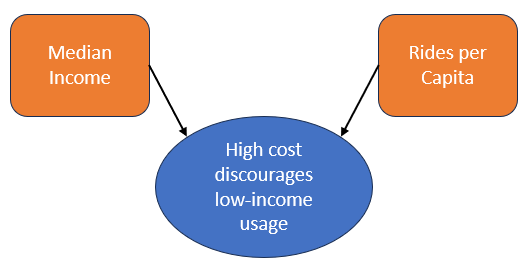Bryce Russell-Benoit
Latent Construct
I would like to understand if the cost of BlueBike rental and membership is serving as a barrier to people with lower incomes. When talking with the high school students that visited class, none of them had used BlueBikes and one remarked that they were too expensive and useless compared to a car. This is a completely understandable perspective. Car ownership comes with high fixed costs, but relatively minimal costs related to continued use. If you already own and regularly use a car, why incur the additional cost to ride a bike when a car would function just as well for most trips you take? This is the challenge for all alternate modes of transportation, especially in the US. I’ll avoid ranting about benefits of bike use over car travel, but it would be an injustice to functionally exclude people of lower income from having the same intra-city transit options as those with higher income.
Notably, BlueBikes has a discounted membership for income-eligible riders which brings the cost down to $50 a year instead of $129. The City of Boston has also very recently announced reduced subscription fees for all Boston residents that brings it down to $60 a year. The program will also bring down income-eligible costs to only $5 a year. I’m not sure how long the BlueBikes program has existed, but the Boston program is very new and will not affect the data. I suspect that BlueBikes and the City of Boston found that lower-income riders were not using the system and I doubt that the $50 yearly membership completely eliminated that relationship.
Manifest Variable
Without the ability to see people deciding not to take BlueBikes, comparisons will need to be made using census data and ride counts from stations in residential areas. By taking the total population of the area around each station and totaling the rides at that station, a “rides per person” measure could be calculated. Regressing this measure with income would help determine if there is any relationship between income and rides.
Model

Bias
There are a lot of limitations and potential issues with trying to answer this question. Many areas of Boston are not residential, especially downtown. Counting all rides in areas without residents will create huge outliers. This means that I will need to find a way to distinguish between residential and commercial areas although there will be many areas where this line is blurred. I may also want to distinguish between subscribers and non-subscribers as subscribers will usually be residents which would help me to focus on only resident behavior. Census data is also not exact, and its aggregation may result in some data points that are not entirely representative of reality.
Most importantly, I’m trying to answer a causal question which is incredibly difficult to do in a complex system. If I do discover a correlation between income and BlueBike use, that does not necessarily represent income as a cause. It’s also possible that income is downstream of a more impactful variable.